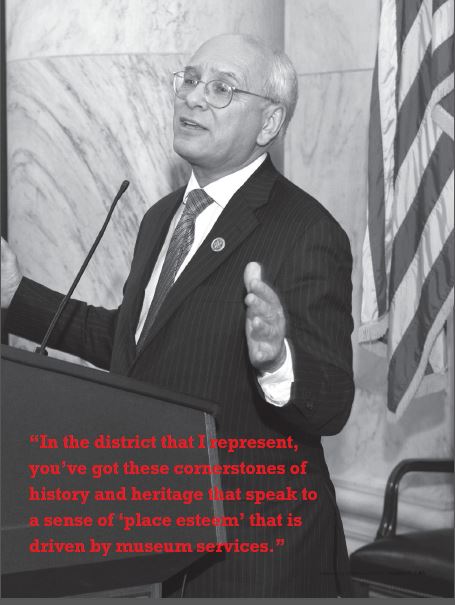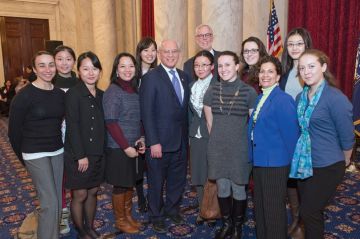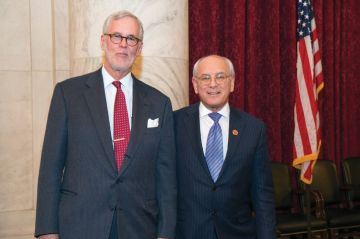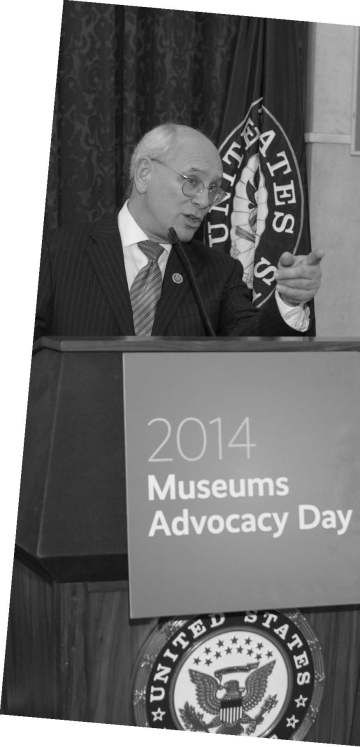
This article originally appeared in the January/February 2015 edition of the Museum magazine.
With preparations underway for a new Congress and for the seventh annual Museums Advocacy Day (Feb. 23–24), Alliance President Ford W. Bell recently sought out an insider’s perspective about the fight for cultural institutions
on Capitol Hill. He spoke with one of our field’s strongest champions in Congress, Rep. Paul Tonko (D-NY). Each of the last six years, Tonko has led the push for increased funding at the IMLS Office of Museum Services by organizing a public sign-on letter for members of Congress.
Congressman, you’ve been a supporter of museum funding and broader arts and culture funding since the day you came to Congress. I think our members and those who read our magazine would be interested to know why you have been such a determined champion of museum funding and why you think it’s important.
This goes back to my state assembly days. I’ve learned that museums are a very important part of the art and cultural education infrastructure. You need to have that balance, depth and breadth in all the disciplines of education. Museum services are prime on the list of education infrastructure that needs to be funded at an appropriate level, enabling us to continue promoting opportunities for communities and states to inform, educate, challenge and inspire. Museums do that abundantly well. In the district that I represent, you’ve got these cornerstones of history and heritage that speak to a sense of “place esteem” that is driven by museum services. Awareness, excitement, and enthusiasm are important dynamics for the community. Place esteem, like self-esteem, is very important. It’s critical to nurturing the spirit and to economic recovery. When people choose to call an area home or the center for their work activities, it’s important that it has a sense of place with significant features. Museums allow us to understand the sense of place and its significance—sharing information on the Battle of Saratoga during the Revolutionary War, for instance, or on construction of the Erie Canal. The 20th District enjoys a rich tapestry of history and cultural heritage. Museums announce that to the world and reinforce the message at home. We use that significance of place as a marketing analysis as a community, as a state. So museums are a key link in bringing heritage to life for learners young and old. They create that underpinning of support that I have always referred to as place esteem.

I’ve used that term many times since I first heard you say it, and it has an amazing effect on people. It really sums up a big part of what museums do.
The message that resonates from museum activity allows us oftentimes to have a comeback scenario. Just like self-esteem speaks to repairing the torn fabric of the individual, the same is true with locations when we repair that fabric and allow people to have a sense of hope and forward thinking. That’s good—it’s empowering.
Empowering is a good word to describe what museums do, as well. You’ve been successful in building a base to support funding at the IMLS Office of Museum Services, for which we’re very grateful. When you talk to your colleagues about funding for IMLS, which is a very small agency, are there other arguments that you have found particularly persuasive?
We have a network in this country of over 17,000 museums, as you know. Those are the centers that emanate a message that builds and challenges our schools, which are constantly called upon to do more with less. Museums are a way to provide universal outreach to students and make an impact. The work we do here in Washington is well served when it goes beyond an accounting ledger, a budget-balancing exercise or bean counting. What we need is anecdotal evidence. Museums should provide those stories, that folklore. Storytelling is important. We should understand that those 17,000 museums provide solid impact. They must provide the anecdotal evidence, put a face on all the work we do and put a story behind our efforts to secure more funding and avoid a cost-cutting mentality that will not get us the results we need. I see it as a mission to work with the museum services community and to lead this letter that calls for an appropriate level of funding for the [IMLS Office of Museum Services] budget. We’re still working through the process this year but hopefully, we’ll use it as a foundation that will enable us to aim higher, even beyond the $31 million that the president has proposed. [Editor’s note: As of press time, Congress had not yet enacted FY 2015 spending legislation.] In the networking of a federal budget, there are investments with a rightful expectation of a lucrative dividend. Our museum services community provides that lucrative dividend by making certain that we lift communities, making them more marketable for jobs. Employers want to bring their work family to areas of significant location, and museums underscore that. Museums also challenge and inspire our youngest in the communities, and are part of the education infrastructure. It is critically important that students have that hands on experience that goes beyond a classroom exercise. When you can see documents or witness certain events of history, you have empowerment that is very important.
“We cannot afford to not invest in cultural ed and arts ed in museums. It will mean a decline in our economic recovery.… People have a desire to delve into history, heritage and historical infrastructure.”

It certainly is. Speaking of the Office of Museum Services and getting signers for the letter, the number of signatories in the House in support of ILMS has grown to 119, up from 25 in 2009.
We’re proud of that.
You’ve led that charge, and we owe you a great debt for that. Thank you.
You’re certainly welcome, but it’s a team-spirited thing. As we develop the support of those 119 members of Congress, we need to acknowledge it’s bipartisan. As we enter a new session of Congress in the 114th, we’re wiping the slate clean. It’s important to come to the table open minded and bipartisan spirited, and suggest that Museum Services deserve and require our working together. The collections of so many valuable artifacts and historic elements that are advanced and shared by museums should propel us into doing the right thing here. We have really
developed a synergy, all of us working together as members of the museum community and legislators who support museums. It continues to grow. The message is real and speaks to the expectation of dividends. A fully engaged Congress understands that these museums house an expression of who we are, where we were and where we want to be. They build hope in the lives of young people and across all ages.
You’re absolutely right about that, Congressman. Federal funding is an important issue to the museum field, but we have a stake in a lot of other issues like education policy and charitable tax incentives, along with the rest of the nonprofit community in our country. That community provides 10 percent of the jobs in our country, which people sometimes forget. Nonprofits are a big industry in our country. With the new Congress convening, do you see any major issues that might impact the museum field that that we haven’t talked about?
I would hope so. Through these last series of campaigns, the whole effort has focused on job creation—cultivating an environment that grows private-sector or not-for-profit jobs. Some of these incentives enable the not-for-profits to get out and grow awareness so that we enhance the connections for museums. It’s very encouraging to hear people who have been able to take some of the youngest and perhaps least likely individuals to museums and see how that sparks within them a sense of discovery, awareness, and importance. It reminds people of the greatness that comes through individual and community involvement, sparking a newfound interest in the heart and soul of individuals.

Our Museums Advocacy Day is coming up February 23rd and 24th. You’ve always been very loyal in attending. When you talk to your colleagues in Congress—especially those who may be saying that we can’t afford to support everything, we have to make choices, we have to cut funding for arts and culture that should be supported locally or should be supported by individuals—what do you find most helpful? Is there anything, in particular, that seems to get their attention?
Well, a lot of times it is about cost-cutting, it’s about not being able to afford something. My argument back is we cannot afford to not invest in cultural ed and arts ed in museums. It will mean a decline in our economic recovery. It’s
very important for us to continue to build upon success, and the hottest buttons of tourism happen to be heritage tourism. People have a desire to delve into history, heritage and historical infrastructure—a reverence for a rather youthful nation. Cultural ed, arts ed and museum community investments drive that economic recovery. I constantly remind people about that: see it as an economic development tool along with an education and tourism concept that emboldens communities, regions, and states. A national network allows us to reach every sector of the country and of the economy and to understand that there should be great pride in building upon the greatness that has preceded us.
You’ve said some very stirring things about museums and arts and culture that will help inform our work. We’re grateful for your dedicated and eloquent support of arts and culture in the museum field. We hope to see you at Museums Advocacy Day again in February.
Let me just add, Ford, that I really believe in this. My efforts to help here are tremendously driven by those who work within this network. The museum community—its career people and its volunteer base—is the passion that drives my efforts.








